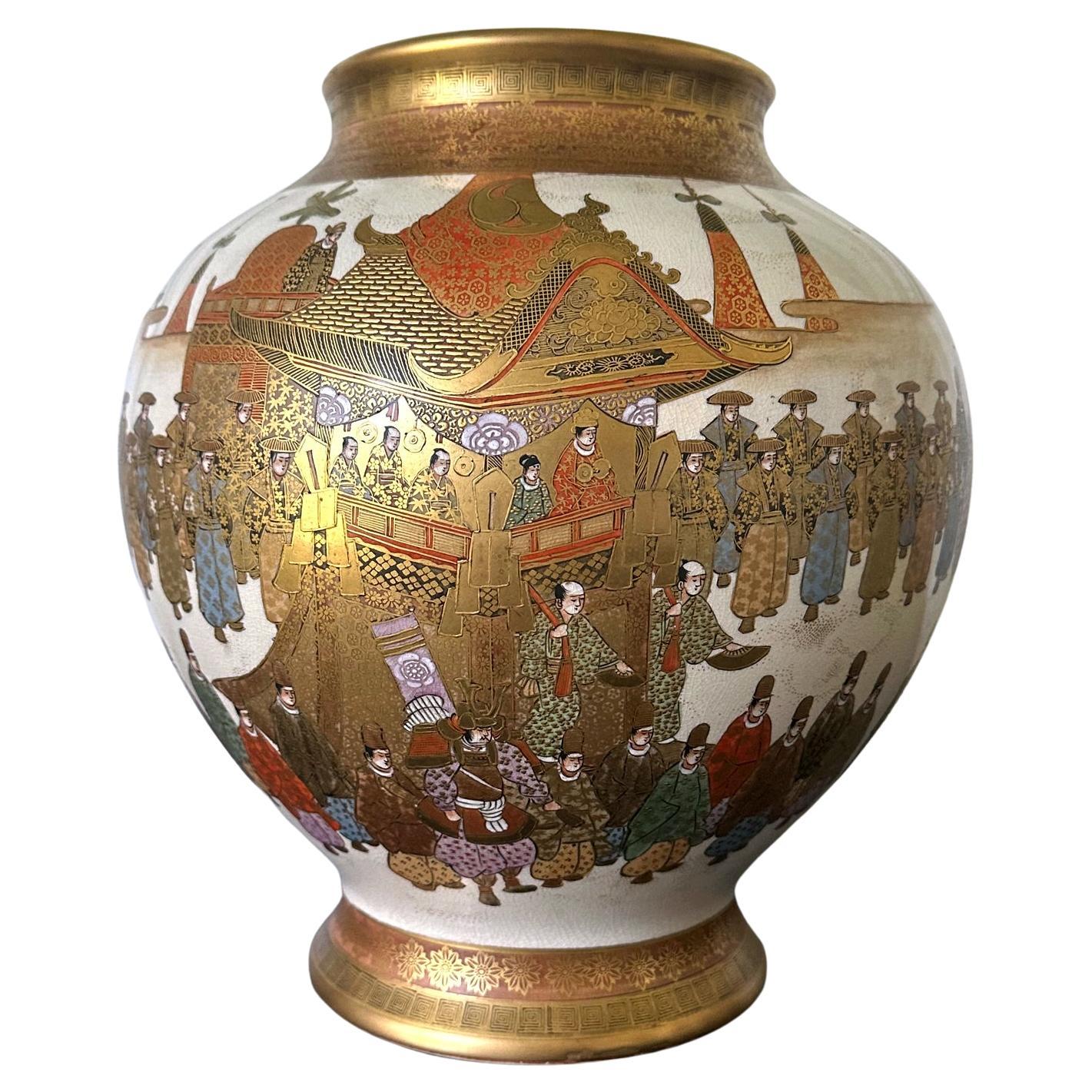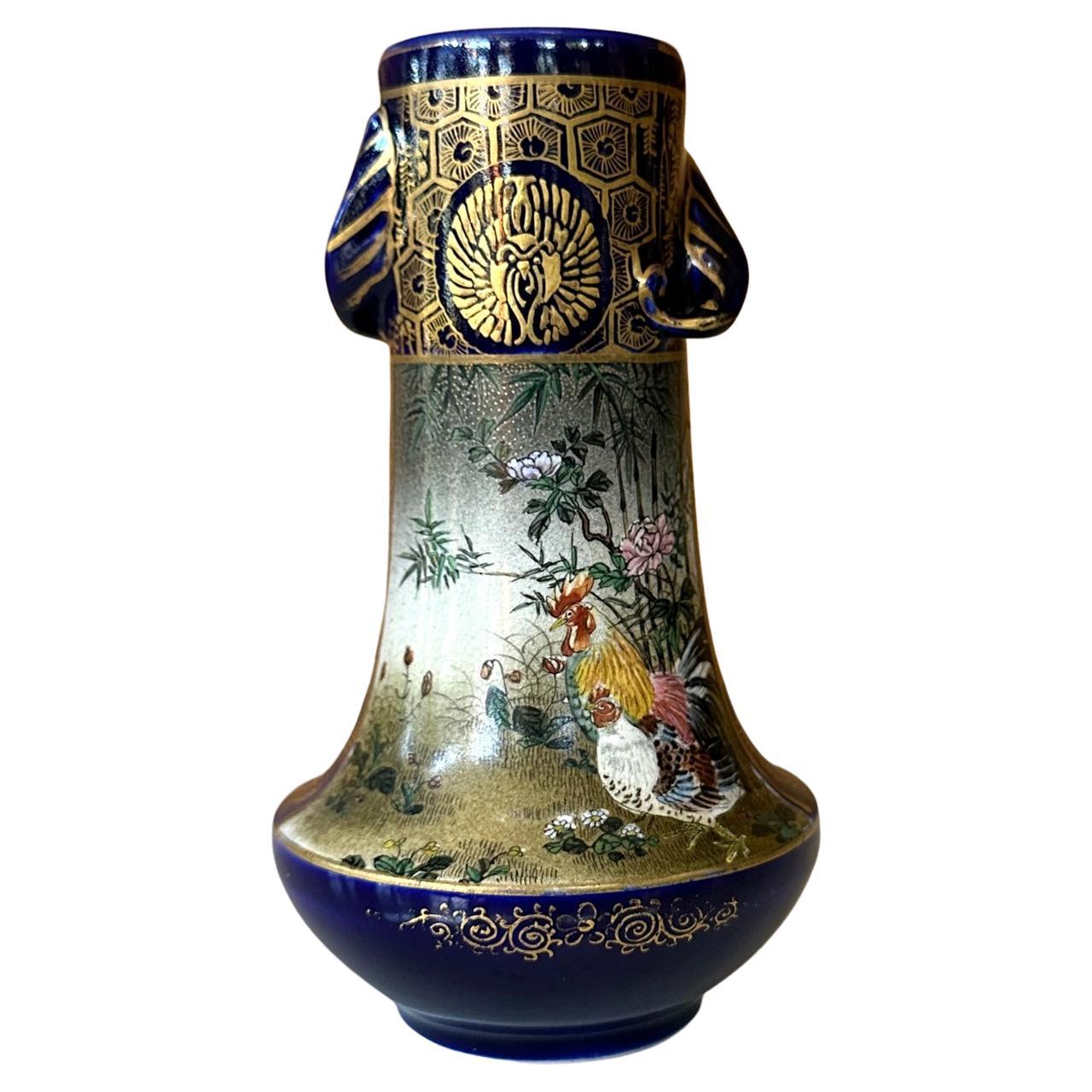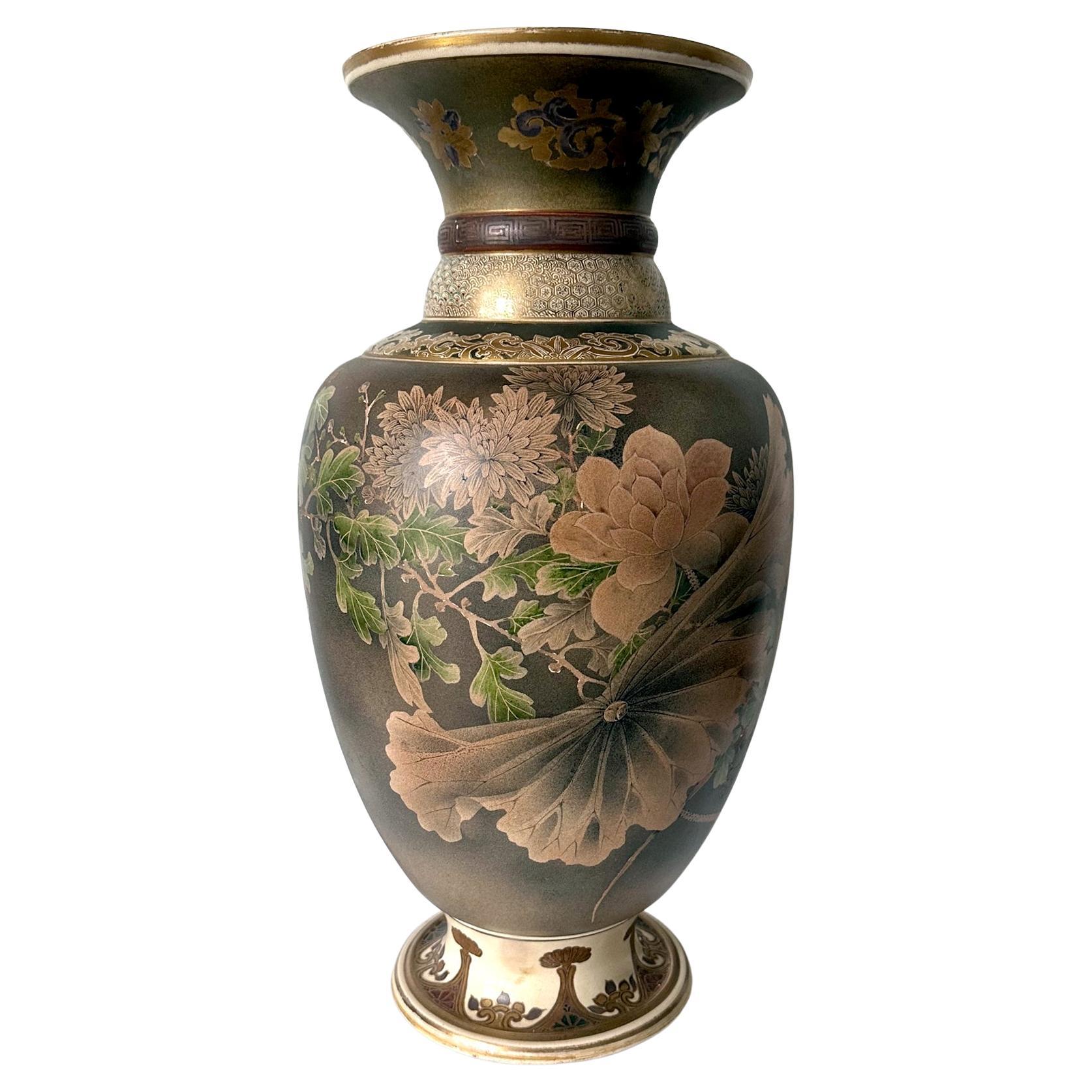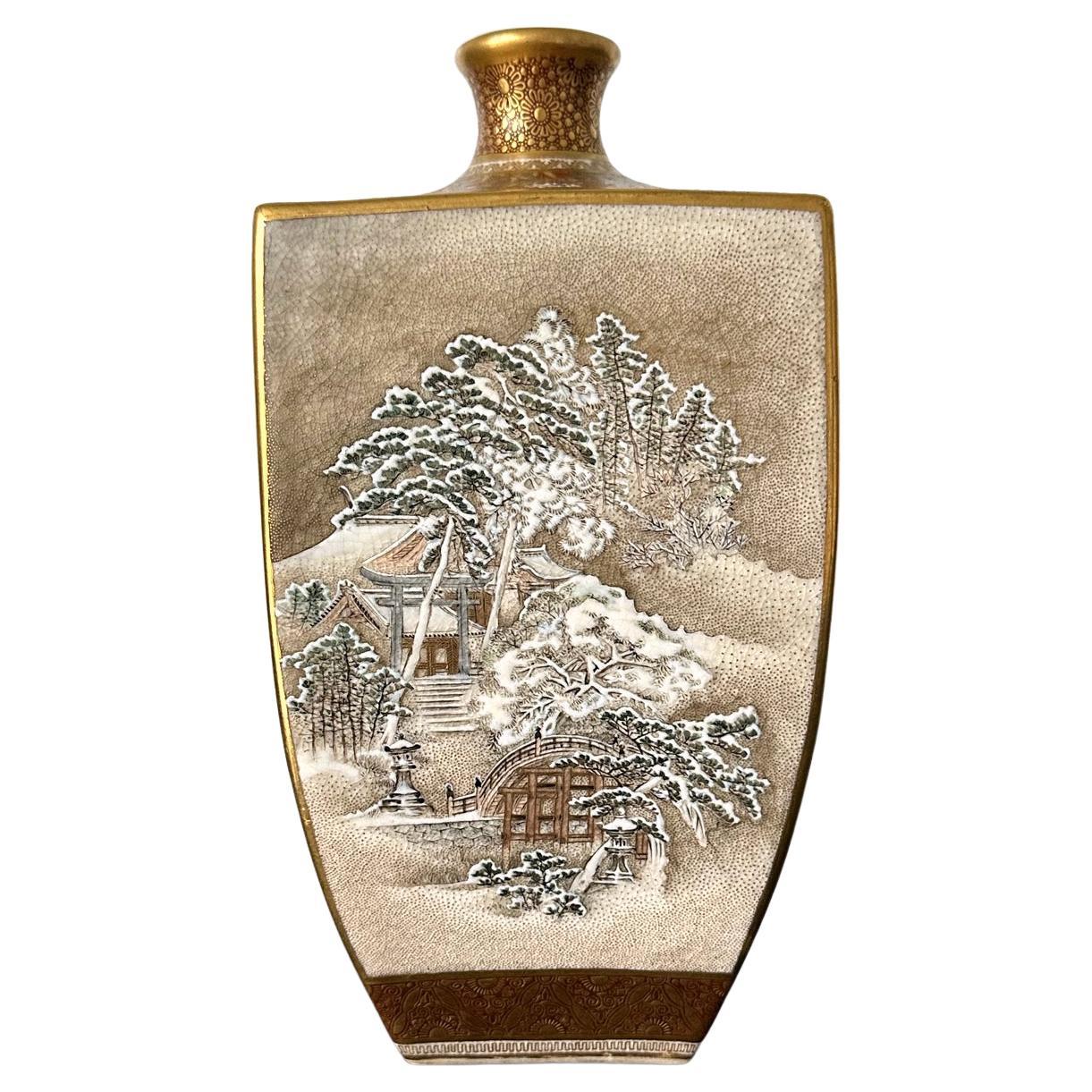Items Similar to Japanese Satsuma Ceramic Dish with Fine Decoration by Kinkozan
Want more images or videos?
Request additional images or videos from the seller
1 of 17
Japanese Satsuma Ceramic Dish with Fine Decoration by Kinkozan
About the Item
A satsuma ceramic dish made by Kinkozan studio circa 1980-1900s in the late Meiji Period. The dish with a thick robust wall is supported by a large ring base and features finely detailed surface decoration, clearly done by a master hand. Surrounded by clusters of chrysanthemums blossoms in a wide range of varieties, the center of the dish showcases two overlapping panels outlined by gilt borders. One panel depicts a couple with the man sitting on the floor while the lady walking away. The figures were elaborately detailed with attires and coiffures and set on a moriage wave pattern background. The other panel depicts a wooded landscape dotted with flowering plants and flying birds, in which two groups of women and children are pictured playing at their leisure. The composition is natural, with movements and an emphasis on depth in dimension. The rim of the dish is encircled with a band of circles and blossom motifs. The base is signed with hand-scripted four-character "Kinkozan Tsukuru" in a black square with gilt scrolling tendril design. The glaze displays an overall even fine crackle. The workmanship is superb and can be catalogized as "miniature art" characterized by the painstaking details. The chrysanthemum clusters were done in a subtly raised moriage with precision in forms and painterly application of colors. The lively rendition of all the characters is meticulous to the tiniest detail such as the raised texture of the woman's white head scarf and woven pattern in their kimonos.
The Kinkozan family established their pottery business first in 1645 and by the end of 19th century, it had become the largest studio producer of Satsuma ware. By the 1850s, Kinkozan Sobei (Kinkozan IV; 1824-84) started to export the wares to the west, particularly to America, together with the Kyoto manufacturer Taizan VIII. This continued and expanded under the leadership of Kinkozan V (1868-1927) until his death in 1927 when the studio closed. Although due to the large output from the studio and target of the markets, the quality varied considerably, Kinkozan did produce some of the best satsuma pieces from Meiji period. This dish is a good example.
- Creator:Kinkozan (Maker)
- Dimensions:Height: 1.75 in (4.45 cm)Diameter: 8.75 in (22.23 cm)
- Style:Meiji (Of the Period)
- Materials and Techniques:Ceramic,Glazed
- Place of Origin:
- Period:
- Date of Manufacture:1890-1900s
- Condition:Wear consistent with age and use. Fine condition with scattered rubbing off the gilt along the rim in keeping with the age.
- Seller Location:Atlanta, GA
- Reference Number:1stDibs: LU945032796252
About the Seller
5.0
Platinum Seller
These expertly vetted sellers are 1stDibs' most experienced sellers and are rated highest by our customers.
Established in 2006
1stDibs seller since 2010
479 sales on 1stDibs
Typical response time: <1 hour
- ShippingRetrieving quote...Ships From: Atlanta, GA
- Return PolicyA return for this item may be initiated within 2 days of delivery.
More From This SellerView All
- Pair Japanese Satsuma Plates with Miniature Decoration by KinkozanBy KinkozanLocated in Atlanta, GAA pair of Satsuma ceramic plates made by Kinkozan studio circa 1880-1900s during the late Meiji Period. Each dish features miniature enamel decoration o...Category
Antique Late 19th Century Japanese Meiji Ceramics
MaterialsCeramic
- Fine Japanese Satsuma Ceramic Jar with Gilt Decoration by KinkozanBy KinkozanLocated in Atlanta, GAA large Japanese ceramic vase from end of Meiji period circa 1880s- 1910s by Kinkozan (1645-1927). One of the largest studio manufacturers of the export ceramics at the time based in Kyoto. In the typical style of satsuma made at the turn of 20th century, the vase is of a moon jar shape and finely decorated with kinran-de (gold paint) on a cream white background with even fine crackles. What sets this particular vase apart from many lower quality and mass-produced pieces is the meticulously renditioned surface decoration. Lavishly gilded with a continuous design, the carefully composed imagery depicts an elaborately decorated float cart in a festival parade. A group of people are seated within the float with a woman and a child standing in the front. Surrounding the float are streams of marchers dressed...Category
Early 20th Century Japanese Meiji Ceramics
MaterialsCeramic
- Fine Japanese Ceramic Satsuma Vase by KinkozanBy KinkozanLocated in Atlanta, GAA miniature Japanese ceramic vase from the end of Meiji period circa 1880s- 1910s by Kinkozan (1645-1927). One of the largest studio manufacturers of the export ceramics at the time ...Category
Early 20th Century Japanese Meiji Ceramics
MaterialsCeramic
- Large Japanese Satsuma Ceramic Vase KinkozanBy KinkozanLocated in Atlanta, GAA large Japanese ceramic vase from the end of Meiji period circa 1890-1910s by Kinkozan (1645-1927). One of the largest studio manufacturers of the export ceramics at the time based in Kyoto. In the typical style of satsuma made at the turn of 20th century, the vase is elaborately decorated with a rather unusual kinran-de (gold paint) and green enamel highlight on a mottled brown background. The painterly decoration depicts a large seasonal floral arrangement in a circular fashion. Besides the obviously superb craftsmanship, what sets this particular vase apart from many lower quality and mass-produced pieces is its tone-on-tone color pallet that is visually somber and the small and sensitive details that heralds the change of the seasons. When the viewer goes beyond the first casual glimpse of the blossom and foliage, one would notice that on the edges of certain leaves as well as along the stalks, there accumulates a very thin layer of the white dust that represents the frost. The flower in bloom are chrysanthemums. Despite of being splendid, they are the messengers of the autumn. The large lotus leaf was subtly rendered in a bended and slightly withered manner, just past its prime. Although the lotus is still in bloom, the prominent seed pod indicates it may be the last for the season. The sentimental capture of the change of the seasons is not unusual in Japanese art. This vase poetically represents such a subtle transition from summer to fall, perhaps depicting the very first frost. The neck of the vase is also slightly unusual with two rolled rings...Category
Early 20th Century Japanese Meiji Ceramics
MaterialsCeramic
- Fine Japanese Ceramic Plate by Kinkozan for Yamanaka & Co.By KinkozanLocated in Atlanta, GAA fine Japanese ceramic satsuma plate made by Kinkozan and retailed by Yamanaka & Co. circa 1900-20s (late Meiji to early Tasho Period). The cream-color glazed plate features a very fine decoration of a persimmon tree bearing fruits. The composition is poetic, stylized but also realistic, with a literati painter's quality, and was advantageously enhanced by the enamel colorings in incredible details. The mastership of the medium came through the piece. It is signed on the base in gilt kanji seal (Made by Kinkozan) and branded Yamanaka & Co in English. The plate was likely commissioned by the company from Kinkozan for its various galleries in US and Europe. The Kinkozan family established their pottery business first in 1645 and by the end of 19th century, it had become the largest studio producer of Satsuma ware. By the 1850s, Kinkozan Sobei...Category
Early 20th Century Japanese Meiji Ceramics
MaterialsCeramic
- Fine Japanese Ceramic Plate by Kinkozan for Yamanaka & Co.By KinkozanLocated in Atlanta, GAA fine Japanese ceramic satsuma plate made by Kinkozan and retailed by Yamanaka & Co. circa 1900-20s (late Meiji to early Tasho Period). The cream-color glazed plate features a very fine decoration of a persimmon tree bearing fruits. The composition is poetic, stylized but also realistic, with a literati painter's quality, and was advantageously enhanced by the enamel colorings in incredible details. The mastership of the medium came through the piece. It is signed on the base in gilt kanji seal (Made by Kinkozan) and branded Yamanaka & Co in English. The plate was likely commissioned by the company from Kinkozan for its various galleries in US and Europe. The Kinkozan family established their pottery business first in 1645 and by the end of 19th century, it had become the largest studio producer of Satsuma ware. By the 1850s, Kinkozan Sobei...Category
Early 20th Century Japanese Meiji Ceramics
MaterialsCeramic
You May Also Like
- Japanese Meiji Period Satsuma Bowl Signed SuizanLocated in Newark, EnglandJapanese Meiji period satsuma scalloped shaped bowl. The bowl of beautiful form with gilt pin-striping and dotting to the accented areas. The exterior decorated with multiple fish swimming around the outside with small flower sprays between. To the inside a painted netting covers the bowl with butterflies and further floral sprays. The centre decorated with representations of each of the woodcut prints from Hiroshige's Tokaido gojusan tsugi (53 Stations of the Tokaido Road). To the base a stylised cartouche signature within an oval for Suizan. This Japanese satsuma bowl...Category
Antique Late 19th Century Japanese Meiji Ceramics
MaterialsCeramic, Earthenware, Pottery
- Satsuma Earthenware Vase, by Kinkozan, Japanese, Meiji PeriodBy SatsumaLocated in West Palm Beach, FLA Satsuma Earthenware Vase, by Kinkozan, Japanese, Meiji period (1868-1912) decorated in polychrome enamels and gilt over a clear, crackled glaze, delicately painted with ladies and men, the reverse with a flowering garden with sprays of flowers, the neck with geometric and floral designs, a band of kifu heads in silver and gilt above the foot, on a midnight-blue ground, signed Kinkozan zo...Category
Antique 1860s Vases
MaterialsEarthenware
- Japanese Porcelain Dish or Plate hand painted wheels, Meiji Period circa 1870Located in Lincoln, LincolnshireThis is a good quality and very decorative Japanese porcelain dish or plate, which we date to the Meiji period, circa 1870. The dish is well potted on a low foot with a frilled wav...Category
Antique 19th Century Japanese Meiji Ceramics
MaterialsPorcelain
- Large Japanese Kutani Satsuma Bowl Hand-Painted Marked to Base, Circa 1940Located in Lincoln, LincolnshireThis is a high quality Earthenware Japanese Satsuma - Kutani large Bowl, beautifully hand decorated and dating to Circa 1940. This is a well potte...Category
Mid-20th Century Japanese Mid-Century Modern Decorative Bowls
MaterialsEarthenware
- Japanese Meiji Porcelain Charger with Fish ThemeLocated in New York, NYJapanese Meiji period large porcelain charger with fish theme and decorative border. The piece was likely made during the Meiji Period. In gre...Category
Antique 19th Century Japanese Meiji Ceramics
MaterialsPorcelain
- Japanese Contemporary Blue Porcelain Charger by Master Artist, 2Located in Takarazuka, JPMesmerizing Japanese contemporary museum quality highly collectible decorative porcelain rectangular charger, extremely intricately gilded and hand painted in blue and red, a signed ...Category
21st Century and Contemporary Japanese Meiji Decorative Dishes and Vide-...
MaterialsPorcelain





